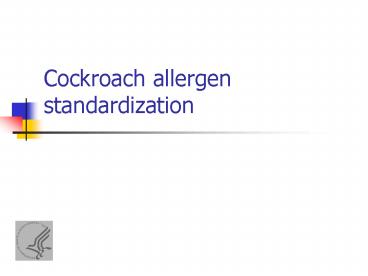Cockroach allergen standardization - PowerPoint PPT Presentation
1 / 28
Title:
Cockroach allergen standardization
Description:
Standardization of cockroach allergen extracts supported by the Allergenic ... Figure legends: Antibody/detector system. Antigen/analyte. 24 /28 ... – PowerPoint PPT presentation
Number of Views:56
Avg rating:3.0/5.0
Title: Cockroach allergen standardization
1
Cockroach allergen standardization
2
Cockroaches
3
Cockroach allergen standardization
- Clinical studies
- Developing the appropriate surrogate
- Correlation
- Depletion studies
- Fab and scFv combinatorial libraries to cockroach
allergens
4
Why is cockroach allergy important?
- Ubiquitous
- Difficult to control
- Associated with asthma
- Standardization of cockroach allergen extracts
supported by the Allergenic Products Advisory
Committee on February 10, 2000
5
Why is cockroach allergen standardization
important?
- To the patient
- More accurate diagnosis
- Safer and more effective immunotherapy
- To the physician/scientist
- Better science (if you cant measure it, you
cant study it) - Pathophysiology
- Epidemiology
- Environmental control
- To the FDA
- Safer, more effective product
6
Initial studies Laboratory
- Develop/adapt methods for allergen determination
- Compare allergen content of different lots
7
(No Transcript)
8
Conclusions
- Commercially available cockroach allergen
extracts - vary widely in protein content, Bla g 2 content,
SDS-PAGE banding pattern, and overall
allergenicity. - appear to be less potent and contain less Bla g 1
than the candidate reference extracts - Established that cockroach allergen vaccines need
to be standardized
9
Next stage Clinical
- skin testing, histamine release, IT data
- establish biological unitage and ideal dosing
ranges
10
Goals
- Obtain valid clinical data on the biological
potency of three commercial German cockroach
allergen extracts - Develop surrogate potency testing
11
Goals
- Obtain valid clinical data on the biological
potency of three commercial German cockroach
allergen extracts - Develop surrogate potency testing
12
ID50EAL testing (Intradermal Dilution for 50 mm
Sum of Erythema Determines Bioequivalent Allergy
Units)
13
NIAID Inner City Asthma Consortium
established in FY 2002 to explore and evaluate
promising new strategies for the treatment of
asthma among minority children residing in the
inner city. This consortium of basic scientists
and clinical investigators will conduct clinical
studies to elucidate the immunopathogenesis and
natural history of asthma in this population.
From the FY 2003 Budget Justification Narrative,
NIAID, http//www.niaid.nih.gov/director/congress
/2002/cj/narrative.htm
14
NIAID Inner City Asthma Consortium steering
committee
- William W. Busse, MD, Chair
- Gordon R. Bloomberg, MD
- Peyton A. Eggleston, MD
- Peter Gergen, MD, MPH
- James Gern, MD
- Rebecca S. Gruchalla, MD, PhD
- Meyer Kattan, MD
- Carolyn M. Kercsmar, MD
- Andrew H. Liu, MD
- Floyd J. Malveaux, MD, PhD
- Herman Mitchell, PhD
- Wayne Morgan, MD, CM
- George T. OConnor, MD, MS
- Jacqueline A. Pongracic, MD
- Hugh A. Sampson, MD
- Sampson Sarpong, MD
- Ernestine Smartt, RN
- Robert C. Strunk, MD
- Stanley J. Szefler, MD
15
(No Transcript)
16
Recruitment
- Inclusion criteria
- 18 to 65 years of age
- history of allergic disease, such as allergic
rhinitis, related to exposure to the allergen of
interest - puncture sum of erythema diameter responses (SE)
to the allergen concentrate of 30 mm.
17
Recruitment
- Exclusion criteria
- Asthma with use of systemic steroids in the past
12 months - Peak flow lt 75 predicted at the time of testing
- Skin coloring or condition that would preclude
the measurement of erythema responses - Dermographism (gt 4 mm SE following saline skin
test) - Immunotherapy past or present - with the test
allergen - Current use of antihistamines, tricyclic
antidepressants, MAO inhibitors, and beta-blockers
18
Allergen extracts chosen
- German cockroach
- Approved for skin testing
- 50 glycerol
- 3 different manufacturers
19
RP1 pooled monospecific rabbit sera against Bla
g 1, 2, 4 and 5 RP2 rabbit anti-German
cockroach RP3 human serum pool S1CR
20
Timetable
- Steering committee approval - done
- Study centers identified - done
- Order extracts - done
- IRB approvals - done
- IND approval - done
- Distribute materials - done
- Proficiency testing - in process
- Proceed with study
21
Goals
- Obtain valid clinical data on the biological
potency of three commercial German cockroach
allergen extracts - Develop surrogate potency testing
22
Surrogate tests to be evaluated
- Competition ELISA (using study sera)
- Specific allergen testing
- Direct ELISA
- Rabbit hyperimmune sera
- Clonal chicken and rabbit scFv and Fab
- Two-site ELISA
- Antibody microarray profiles
- Sensitized mast cell lines (H. Sampson)
23
Figure legends
- Antibody/detector system
- Antigen/analyte
24
Competition ELISA with pooled allergic human sera
- Examples mites, grasses
- Advantages
- quantitative
- reflects spectrum of allergen recognition
- does not require identification of relevant
allergens - Disadvantages
- use of pooled sera
- effects of fluctuations in individual allergens
difficult to measure
25
ELISA with monospecific antiserum
- Advantages
- quantitative
- monospecific
- Disadvantages
- need to identify relevant allergen(s)
26
Two-site ELISA with monoclonal antibodies
- Advantages
- specificity
- Disadvantages
- specificity
- need to identify relevant allergen(s)
- cross-reactivity
27
Antibody microarray
- Advantages
- quantitative
- reflects spectrum of allergen recognition
- does not require identification of relevant
allergens - Disadvantage
- New technology initial development will be labor
intensive and expensive
28
Conclusions
- Standardized German and American cockroach
allergen vaccines will - facilitate definitive studies on the role of
cockroach allergens in inner city asthma, and on
the best methods for eradication and treatment - make for safer and more effective products































